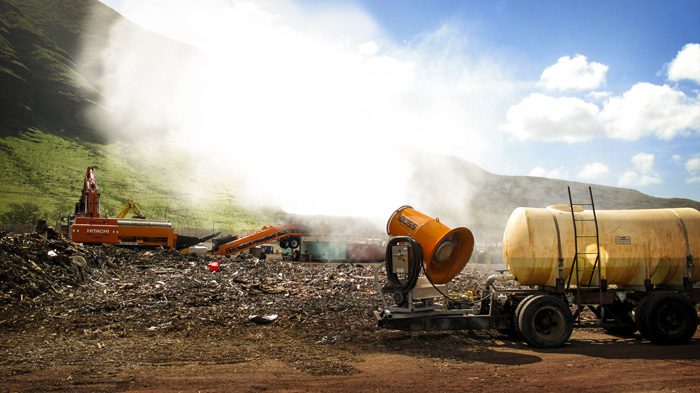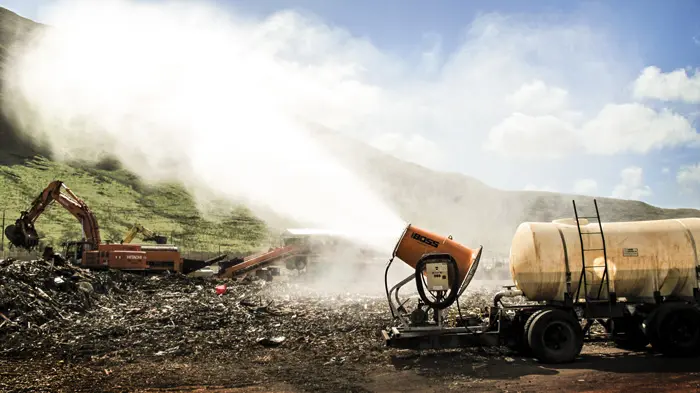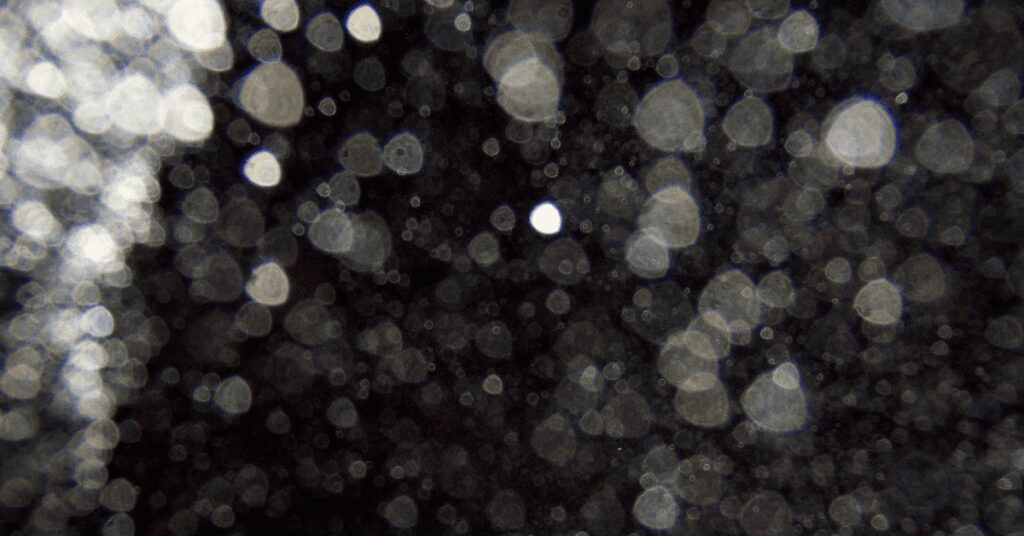
"It’s not uncommon for temperatures to reach 90° or more out there and having that fine mist projected over such a large working area really helps the men stay comfortable.”
- Steve Joseph
General Manager
With an annual rainfall as low as 4 in (10 cm), dust can be a serious problem for a landfill in the island of Oahu in Hawaii.
PVT has found the key to landfill dust control on a 100-yard working face of compacted and buried material, using a powerful, fan-driven misting system that delivers the additional benefit of cooling both the job site and workers.
Facility engineers have mounted the unit on a lowboy trailer, paired with a generator and small water truck to deliver complete mobility across the entire site. The mobile setup can cover more than 20,000 square feet from a single location, creating a virtual dust blanket that helps protect workers and the neighboring residential community from potential hazards and nuisance.
The landfill processes 200,000-300,000 tons of construction and demolition waste each year, including non-hazardous materials such as concrete, asphalt, wood, glass, masonry, roofing, rock, dirt and siding.
“We initially used conventional water trucks to help control the dust, and we continue to use them on roads and high-traffic areas,” said General Manager Steve Joseph. “But we wanted a dust management technique that would give us more coverage.”
PVT investigated several dust control options, but none of the equipment designs seemed powerful enough. After hearing about a coal-fired power generation facility on the island that was successfully using a DustBoss DB-60 , Joseph decided to pay the site a visit. He found the equipment to be effective at managing the huge potential for dust in the coal handling operation, and he was convinced it would deliver similar results in his own process.
Waste to Energy
One reason PVT officials wanted to expand their dust control capability was an upgrade plan that involves digging up much of the existing landfill, which is nearing its capacity. By mining the site for burnables and recyclables, operators will extend its life and extract valuable materials that need not be landfilled.
With the addition of a 10-station sorting line and an Extec primary waste shredder, the company will sort wood, plastic, carpet, rubber, metals and other debris, run it through a separator and then the shredder.
The Extec model 3600 shredder is a mobile unit that is capable of handling a wide range of C&D debris, scrap metal, tires and many other materials, a versatility that comes in handy at PVT. The shredded material will be used as fuel to generate electricity and synthetic natural gas on the island.
Currently, waste material is dumped on the working face and moved with a Komatsu WA380 front-end loader and compacted by a Komatsu 375 dozer. At the end of the day, coal ash and dirt are used to cover the compacted waste. With 5-10 trucks working at any given time in the hot, dry weather, the dust potential is significant.
Operating crews run the DustBoss 4–8 hours per day on average, wherever movement or compacting of debris has the potential to create a dust problem.
With the shredder online, PVT is now well-equipped to handle any dust that may arise. The company also crushes asphalt, concrete, and rock for use on its roadways and as rip-rap to prevent erosion.
With the versatility of the self-contained mobile suppression system and the large coverage area of the DustBoss, Joseph says they’re prepared to suppress airborne particles and surface dust from virtually any source.
“The system does a great job for us,” said Joseph. “It has great coverage and really knocks down the dust, and the cooling aspect is a nice bonus. It’s not uncommon for temperatures to reach 90° or more out there and having that fine mist projected over such a large working area really helps the men stay comfortable.”
CUSTOMER
PVT Landfill
LOCATION
Nanakuli, Hawaii (US)
CHALLENGE
Find a more effective option than conventional water trucks for suppressing dust across a 100-yard working face of compacted and buried landfill material, as part of an upgrade to mine the site for extractable materials that could be burned for fuel or recycled.
SOLUTION
One DustBoss DB-60
RESULTS
Facility engineers have mounted the unit on a lowboy trailer, paired with a generator and small water truck to deliver complete mobility across the entire site. Operating crew run the unit 4-8 hours per day on average, wherever movement or compacting of debris has the potential to create a dust problem. The DustBoss delivers excellent coverage and effectively suppresses dust, with the added benefit of helping workers stay cool in the hot tropical climate.
PVT LANDFILL
is a licensed C&D material solid waste facility, accepting non-hazardous materials such as concrete, asphalt, wood, glass, masonry, roofing, rock, dirt, boulders and siding. The facility is approved to accept asbestos-containing materials and petroleum-contaminated soils, in addition to petroleum products for solidification, such as gasoline, diesel or heavier oils. The landfill also has an evaporating pond used for separating solid waste from dirty water brought to the site.
"It’s not uncommon for temperatures to reach 90° or more out there and having that fine mist projected over such a large working area really helps the men stay comfortable.”
- Steve Joseph
General Manager
With an annual rainfall as low as 4 in (10 cm), dust can be a serious problem for a landfill in the island of Oahu in Hawaii.
PVT has found the key to landfill dust control on a 100-yard working face of compacted and buried material, using a powerful, fan-driven misting system that delivers the additional benefit of cooling both the job site and workers.
Facility engineers have mounted the unit on a lowboy trailer, paired with a generator and small water truck to deliver complete mobility across the entire site. The mobile setup can cover more than 20,000 square feet from a single location, creating a virtual dust blanket that helps protect workers and the neighboring residential community from potential hazards and nuisance.
The landfill processes 200,000-300,000 tons of construction and demolition waste each year, including non-hazardous materials such as concrete, asphalt, wood, glass, masonry, roofing, rock, dirt and siding.
“We initially used conventional water trucks to help control the dust, and we continue to use them on roads and high-traffic areas,” said General Manager Steve Joseph. “But we wanted a dust management technique that would give us more coverage.”
PVT investigated several dust control options, but none of the equipment designs seemed powerful enough. After hearing about a coal-fired power generation facility on the island that was successfully using a DustBoss DB-60 , Joseph decided to pay the site a visit. He found the equipment to be effective at managing the huge potential for dust in the coal handling operation, and he was convinced it would deliver similar results in his own process.
Waste to Energy
One reason PVT officials wanted to expand their dust control capability was an upgrade plan that involves digging up much of the existing landfill, which is nearing its capacity. By mining the site for burnables and recyclables, operators will extend its life and extract valuable materials that need not be landfilled.
With the addition of a 10-station sorting line and an Extec primary waste shredder, the company will sort wood, plastic, carpet, rubber, metals and other debris, run it through a separator and then the shredder.
The Extec model 3600 shredder is a mobile unit that is capable of handling a wide range of C&D debris, scrap metal, tires and many other materials, a versatility that comes in handy at PVT. The shredded material will be used as fuel to generate electricity and synthetic natural gas on the island.
Currently, waste material is dumped on the working face and moved with a Komatsu WA380 front-end loader and compacted by a Komatsu 375 dozer. At the end of the day, coal ash and dirt are used to cover the compacted waste. With 5-10 trucks working at any given time in the hot, dry weather, the dust potential is significant.
Operating crews run the DustBoss 4–8 hours per day on average, wherever movement or compacting of debris has the potential to create a dust problem.
With the shredder online, PVT is now well-equipped to handle any dust that may arise. The company also crushes asphalt, concrete, and rock for use on its roadways and as rip-rap to prevent erosion.
With the versatility of the self-contained mobile suppression system and the large coverage area of the DustBoss, Joseph says they’re prepared to suppress airborne particles and surface dust from virtually any source.
“The system does a great job for us,” said Joseph. “It has great coverage and really knocks down the dust, and the cooling aspect is a nice bonus. It’s not uncommon for temperatures to reach 90° or more out there and having that fine mist projected over such a large working area really helps the men stay comfortable.”
Implement Dust Control at Your Jobsite!
Receive a FREE quote and talk to a dust control specialist today to stop fugitive dust!
Get A Quote
More on BossTek
Subscribe and Stay Up-to-Date!
Receive a monthly newsletter keeping you up-to-date on the latest in dust and odor control.
Subscribe






